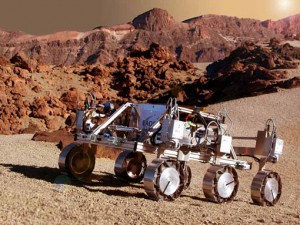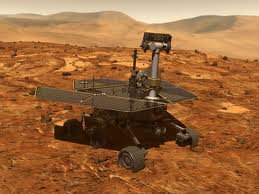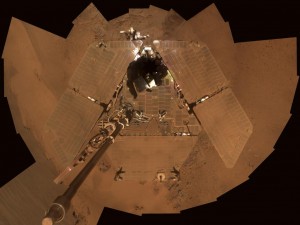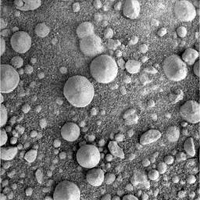In the history of Mars exploration, only seven landings have been successful. Spirit and Opportunity, the Mars exploration rovers, are some of these spectacular Mars landers successes. Here, we explore the mission, launch, landing, discoveries, facts and status of the two rovers.

Spirit and Opportunity Mission Overview
Spirit and Opportunity were twin robotic Mars exploration rovers (MER) launched in 2003 by NASA on a three-month mission to explore Mars. The rovers were part of the Mars Exploration Program, a long-term mission to explore the red planet.
Mars Exploration Rovers Mission Objectives
The main purpose of the mission was to look for signs of water activity in the planet’s past. The rovers were to do this by studying a wide range of rocks and soil for clues to past water activity on Mars.
The landing sites for the two rovers were strategically picked to accomplish this goal. While the rovers’ destinations were on opposite sides of the planet, both landing sites had signs that liquid water was present in the past.
Other objectives were to investigate the abundances of minerals, find out the geological processes that resulted into the Martian terrain and investigate the conditions that were present when liquid water existed on the planet.
The Rovers Design
NASA’s Jet Propulsion Laboratory was in charge of the design and development of the rovers as well as the operation and management of the mission.
The rovers were six wheeled and the size of a golf cart with the ability to move 100 meters a day while performing geological investigations. They had cameras to help them spot and avoid hazards on their way making navigation smooth.
To find appropriate names for the two rovers, MER-A and MER-B, a contest was held. MER-A was named Spirit while MER-B was named Opportunity.

The Twin Rovers Scientific Instruments
Each of the rovers was equipped with two cameras, spectrometers, excellent tools and other scientific instruments designed to accomplish the mission objectives.
A Panoramic Camera (Pancam) takes high-resolution images of the surface and the sky while a Microscopic Imager (MI) captures microscopic images of rock and soil samples.
A Miniature Thermal Emission Spectrometer (Mini-TES), an infrared spectrometer that analyzes rock and soil samples to determine their composition, a Mossbauer Spectrometer (MB) analyzes iron-rich minerals, and an Alpha Particle X-Ray Spectrometer (APXS) investigates the abundance of minerals in soil and rocks.
A Rock Abrasion Tool (RAT) is a small grinder attached to the robotic arm. It removes the exposed and weathered top layers of rocks exposing the fresh areas for the scientific instruments to analyze.
There are also magnets that pick up magnetic dust particles for the spectrometers to analyze and determine their composition.
Source of Power for the Spirit and Opportunity Rovers
Both rovers were powered by solar panels and Opportunity is still relying on the sun for the power to operate its instruments. These panels are sometimes covered by dust blocking sunlight.
To survive the harsh Martian winter, Opportunity had to stay in a sun-facing slope to keep operating by capturing the little sunlight that was present. Fortunately, the strong Martian wind blew away the dust and the solar panels became operational again.

Spirit and Opportunity Launch and Landing
Launched on 10 June 2003 on a Delta II 7925 rocket from Cape Canaveral, Spirit landed on Mars on 4 January 2004. It landed at Gusev Crater, an impact crater thought to have had a lake in the past.
Opportunity launched on 7 July 2003 on a Delta II 7925H rocket from Cape Canaveral and landed on Mars on 25 January 2004. It landed on the other side of Mars s on the Meridiani Planum, a flat plain whose hematite mineral deposits indicate that water was once present in the region.
A temporary loss of communication with Spirit delayed operations for a few days but both rovers later started their mission by capturing images of their surrounding.
Mars Discoveries by Spirit and Opportunity
Ever since they touched down on the Martian surface, the two rovers have discovered many new things about the red planet. They have transmitted data and images to Earth that scientists analyze for signs of water activity in Mars’ past. Here are the discoveries made by each of the rovers.
Discoveries Made By Opportunity
A few weeks after its landing, Opportunity came across odd iron-rich spherules that scientists nicknamed `blueberries’. Scientists speculate that these blueberries are concretions created when water-borne minerals settled into sedimentary rock. They are therefore signs of water presence in the past of Mars. The rover encountered more of these spherules during its exploration.

In 2012, the rover found another type of spherules with a different structure and composition. Scientists are yet to determine what these are and where they came from and have dubbed them `newberries’.
In March 2004, Opportunity found the significant evidence that water existed on Mars in the past. The rover discovered that the rocks found at its landing site were once drenched in water. Scientists concluded that these rocks resided under a shallow sea that existed in the Meridian region in the past.
In 2005, Opportunity found the first meteorite to be discovered on another planet. It came across a number of large meteorites composed of iron and nickel. Astronomers believe that these meteorites impacted on a wet and soft surface of Mars million of years ago. They remained buried until the water dried up and they were exposed due to erosion.
In 2011, the rover found a thin, bright vein of gypsum along the rim of Endeavour Crater. This is strong evidence of past water presence on Mars. The gypsum is believed to have been deposited by liquid water a long time ago.
The presence of gypsum made Endeavour Crater a site of interest to the rover’s mission. In December 2012, Opportunity focused its attention on a spot on the rim of Endeavour Crater that contains clay minerals an indicator that the region contained relatively neutral water in the past that could have supported life.
Since Opportunity is still going on strong in its exploration of Mars, there is room for it to make many more findings about this mysterious planet.
Discoveries Made by Spirit
At its landing site Gusev Crater, Spirit found basaltic rock, which indicates that the region once experienced a volcanic explosion that involved water and magma mixing. If so, there must have been water in this area.
In 2005, the rover’s cameras beamed back images of dust storms blowing across the planet’s surface. This is just one of the few remaining active processes on the planet that are shaping its landscape. For example, the tracks left behind by the two rovers as they move across the surface are deleted by the strong Martian winds.

In 2007, its wheel dug a trench at Gusev Crater and found bright white deposits made up of pure silica. On Earth, these types of deposits can only form from hot water action on rocks. Astronomers have taken the deposits to be evidence of ancient hydrothermal activity on Mars. It is a clue that some areas of Mars had not only liquid water but also a source of energy, which are two necessities for life to thrive.
Have The Rovers Accomplished Their Main Mission Objective?
The Mars exploration mission has been a huge success since the two rovers met their main goal. They found convincing evidence that Mars had water in the past.
The Mars Exploration Rovers have also revealed other things about Mars. They have shown that there are a few active processes remaining on Mars and that the reflectivity of the land changes depending on whether the dust is settling on rocks or being eroded from them. The rovers also beamed back the first ever images of earth-like clouds on Mars captured from the surface of the planet.
What Spirit and Opportunity have revealed has enabled scientists to create a detailed temperature profile of the Martian atmosphere for the first time.
The two rovers’ findings are inspiring the next generation of space explorers starting with the Mars Curiosity Mission that started in 2012.
For their accomplishments, two asteroids 37452 Spirit and 39382 Opportunity are named after the two rovers.
Are Spirit and Opportunity Still Working?
Spirit and Opportunity were expected to last only 90 days. Due to the harsh Martian environment characterized by freezing temperature, sand traps and dust storms, scientists never expected these two rovers to last any longer. No wonder the scientists were pleasantly surprised when the rovers went on operating for years.
Spirit failed in 2010. Problems started in 2008 when Spirit was on its fifth mission extension. The rover got stuck in soft soil on Mars. Attempts to get it moving again were unsuccessful and NASA re-tasked it to a stationery science platform. In March 2010, all contacts with it was lost and attempts to get back in touch failed. It operated for more than 6 years exploring farther than was expected of it.
Opportunity is still going on strong even today. Its mission has been a huge success. The future of Opportunity is not certain. It could continue operating for years or fail today. Scientists have no idea how long it will go on since they never tested its instruments for failure.
Where is Opportunity Now?
Since its landing in 2004, Opportunity is still exploring the Red Planet and leaving tracks behind. It began a new mission on 8 May 2012, where it will study an unusual bright patch of dust in the Meridiani area. It will also investigate ancient clay found in the Endeavour crater for clues of past water activity.
